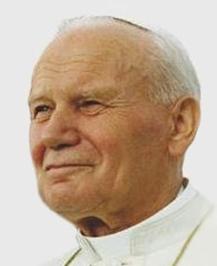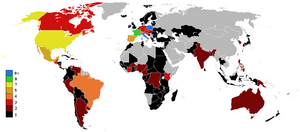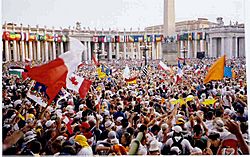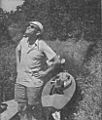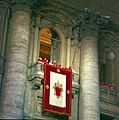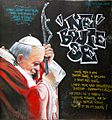Pope John Paul II facts for kids
Quick facts for kids Saint John Paul II |
|
|---|---|
 |
|
| Native name | Ioannes Paulus Secundus |
| Papacy began | 16 October 1978 |
| Papacy ended | 2 April 2005 |
| Predecessor | Pope John Paul I |
| Successor | Pope Benedict XVI |
| Personal details | |
| Birth name | Karol Józef Wojtyła |
| Born | 18 May 1920 Wadowice, Poland |
| Died | 2 April 2005 (aged 84) Apostolic Palace, Vatican City |
| Nationality | Polish with Vatican citizenship |
| Motto | Totus Tuus (Totally Yours - in Latin) |
| Sainthood | |
| Beatified | 1 May 2011 St. Peter's Square, Vatican City by Pope Benedict XVI |
| Canonized | 27 April 2014 St. Peter's Square, Vatican City by Pope Francis |
| Other Popes named John Paul | |
Pope John Paul II (Latin: Ioannes Paulus PP. II; Polish: Jan Paweł II; Italian: Giovanni Paolo II), also known as Saint John Paul, was the leader of the Catholic Church. He served from October 16, 1978, until his death in 2005. He was the second longest-serving pope in history.
Born Karol Józef Wojtyła on May 18, 1920, he was from Poland. This made him the first non-Italian pope in 455 years. The last non-Italian pope before him was Pope Adrian VI, who died in 1523.
Pope John Paul II was the first pope to visit the White House and a mosque. He traveled more than any other pope before him, visiting many countries around the world. He is also famous for starting the yearly World Youth Day, a big gathering for young Catholics. He was made "Blessed" in 2011 and then a "Saint" by Pope Francis on April 27, 2014.
Contents
Early Life and Studies
Karol Józef Wojtyła was born on May 18, 1920, in Wadowice, Poland. His parents were Karol Wojtyła and Emilia Kaczorowska. He was the youngest of three children. His mother died when he was nine years old in 1929. His older brother, a doctor, died when Karol was twelve. By the time he became a priest, he had lost his entire family.
As a young boy, he enjoyed sports, especially playing football (soccer) as a goalkeeper. He went to Marcin Wadowita high school in Wadowice. In 1938, he began studying drama at the Jagiellonian University in Kraków. He also worked as a volunteer librarian. He was an athlete, actor, and playwright. He even did two months of required military training, but he chose not to hold or fire a weapon.
When he was young, he met many Jewish people who lived in his area. In 1939, Nazi forces closed the Jagiellonian University during World War II. All men, except those with disabilities, had to have a job. From 1940 to 1944, Karol worked in a restaurant. He also worked in a limestone quarry and later as a salesman for a chemical factory. He did this to avoid being sent to Germany to join the German army. His father died of a heart attack in February 1941.
On February 29, 1944, Karol was hit by a German truck. He thought he would be treated badly, but German officers sent him to a hospital. He spent two weeks there with head and shoulder injuries. It was during this time that he decided he must become a priest. After leaving the hospital, young Polish men were being sent to Germany for training. He managed to hide at the Archbishop's house until after the war ended. On January 17, 1945, the Germans left Kraków. Priests, teachers, and students returned to the seminary and began cleaning up. Karol offered to clean the restrooms.
That same month, Karol found a fourteen-year-old Jewish refugee named Edith Zierer. She had collapsed from hunger while trying to find her parents. He gave her food and helped her get to the railway station. She did not hear from him again until he was elected Pope.
Becoming a Priest and Bishop
Karol Wojtyła was ordained as a priest by Cardinal Adam Stefan Sapieha on November 1, 1946.
In 1958, at the age of 38, Wojtyła became the youngest bishop in Poland. In 1962, he took part in the Second Vatican Council. This was a very important meeting that changed many things in the Catholic Church. He helped write two key documents about religious freedom and the Church's role in the modern world.
In 1963, Bishop Wojtyła became the Archbishop of Kraków.
Becoming a Cardinal
On June 26, 1967, Pope Paul VI made Archbishop Wojtyła a cardinal. This is a very high rank in the Catholic Church, just below the Pope.
Pope John Paul II
John Paul II became Pope on October 16, 1978. He was the first non-Italian pope in 455 years. He served as pope for 27 years, making him the second longest-serving pope after Pope Pius IX. He was also the first and only Slavic pope. John Paul II was known as the most traveled pope in history, making 104 international trips.
He was very good at languages. He spoke Polish as his first language. He learned Latin and Ancient Greek in school. On the day he officially became Pope, he spoke to people in Italian, English, German, French, Spanish, Czech, and Portuguese. He also knew some Lithuanian, Hungarian, Russian, and Ukrainian.
Pope John Paul II gave many people the title of "Blessed" (called beatification). This means the Church recognizes them as having lived a very holy life. He also made many saints. He gave more people the title of "Blessed" than any other pope in history.
In 1984, John Paul II started World Youth Day. The first event was in Rome and about 300,000 young people attended. Since then, it has been held in a different country every few years. It encourages young people to be faithful to God and to live together in peace. Millions of people have attended these events.
The Pope's Travels
John Paul II loved to travel, just like Pope Paul VI before him. As pope, he made 105 trips, visiting 117 countries. In total, he traveled more than 1.1 million kilometers (725,000 miles). Wherever he went, large crowds came to see him. All these trips were paid for by the countries he visited, not by the Vatican.
One of his first official visits was to his home country of Poland in June 1979. There, he was always surrounded by happy, cheering crowds. The Pope wanted to bring freedom and human rights to his country. His visit encouraged Poles to stand up against communism. In 1980, the Solidarity movement, which fought for freedom, was born. On later trips to Poland, he made his message of support even stronger. The Soviet Union had controlled Eastern Europe for many years. In 1989, Poland was the first country to begin to break free from Soviet control.
John Paul II visited places other popes had been before, like the United States and The Holy Land. He also went to many countries that no pope had ever visited. He was the first reigning pope to travel to the United Kingdom, where he met Queen Elizabeth II, the head of the Church of England.
In 1982, the Pope visited Japan, and in 1984, he went to South Korea and Puerto Rico. He was the first pope to visit Cuba. During his visit in January 1998, he spoke strongly against Cuba not allowing people to practice their religion freely. He also criticized the United States' trade embargo against Cuba. In 2000, he became the first modern Catholic pope to visit Egypt. There, he met with the Coptic Pope and the Greek Orthodox Patriarch of Alexandria. In 2001, he was the first Catholic Pope to visit and pray in an Islamic mosque in Damascus, Syria. He visited the Umayyad Mosque, where John the Baptist is believed to be buried.
In 1988, he traveled to Lesotho to beatify Joseph Gérard. On January 15, 1995, during the 10th World Youth Day, he held a Mass for an estimated four to eight million people in Luneta Park, Manila, Philippines. This is thought to be the largest single event in Christian history.
After the attacks on September 11, 2001, even though people worried about his safety, the Pope traveled to Kazakhstan. He spoke to large groups, including many Muslims. He also went to Armenia to celebrate 1700 years of Christianity there. During some visits, he said Mass in local languages, such as Kiswahili in Nairobi, Kenya in 1995, and an Indonesian language in East Timor.
During his trips, the Pope always showed his strong devotion to the Blessed Virgin Mary. He visited many special churches and places dedicated to her, including Knock in Ireland, Licheń Stary in Poland, Fátima in Portugal, Guadalupe in Mexico, and Lourdes in France.
Assassination Attempt
On May 13, 1981, the Pope was shot twice in the abdomen by a Turkish man named Mehmet Ali Ağca. The Pope was badly hurt and barely survived the attack. He had to stay in the hospital for 20 days. Later, the Pope visited Ağca in prison and told him he had already forgiven him. Exactly one year later, he traveled to Fatima to thank Mary, Mother of God, for saving his life.
On this same trip, there was a second attempt on his life. A follower of the French archbishop Marcel Lefebvre tried to hurt the Pope with a bayonet. The Pope's bodyguards quickly stopped him. Lefebvre and his followers disagreed with the decisions made at the Second Vatican Council. After this, the Pope often traveled in a bullet-proof vehicle known as the "popemobile."
Death and Sainthood
Pope John Paul II died on Saturday, April 2, 2005, at 9:37 pm. His death certificate stated that he had Parkinson's disease and serious breathing problems. He had tracheotomy surgery in February, but it did not help, and he lost a lot of weight. He also had other health issues. The cause of death was kidney failure, which led to blood poisoning and infection. John Paul II's last words were, “pozwólcie mi odejść do domu Ojca” (meaning “Let me depart to the house of the Father”). He fell into a coma about four hours later.
After his death, as is tradition, his name was called three times. When there was no answer, his special papal ring was broken. This showed that John Paul II's time as pope had ended.
Many people felt that Pope John Paul II had blessed them during his time as Pope. Many thought he should be given the title "Blessed." This process usually takes at least five years. On May 13, 2005, Pope Benedict XVI decided to start the beatification process for John Paul II sooner than usual. The only other time this happened recently was for Mother Teresa, who was made Blessed Mother Teresa by John Paul II himself.
It was announced on January 14, 2011, that John Paul II would be beatified on May 1, 2011. His remains were moved from the grotto beneath St. Peter's Basilica to a more visible place in the Chapel of St. Sebastian. This allows more visitors to see his memorial.
On September 30, 2013, Pope Francis announced that John Paul II, along with Pope John XXIII, would be made saints on April 27, 2014. This was the first time two popes were made saints on the same day.
Related pages
Images for kids
-
Karol Wojtyła (second from right) in a Baudienst forced labor work crew during the German occupation of Poland in WWII, around 1941
-
Karol Wojtyła pictured during a kayaking trip to the countryside with a groups of students, around 1960
-
John Paul II with the president of Italy Sandro Pertini in 1984
-
US President Ronald Reagan meeting with Pope John Paul II during a visit to the Vatican City, 1982
-
John Paul II was the first Pope to enter and pray in a mosque, visiting the tomb of John the Baptist at Umayyad Mosque, Damascus.
-
The tomb of John Paul II in the Vatican Chapel of Saint Sebastian within St. Peter's Basilica where it has been since 2011.
-
1.5 million St. Peter's Square attendees witness the beatification of John Paul II on May 1, 2011, in Vatican City
-
Statue of John Paul II outside the Basilica of Our Lady of Guadalupe, Tepeyac, Mexico City
See also
 In Spanish: Juan Pablo II para niños
In Spanish: Juan Pablo II para niños


